Is Passwordless Authentication More Secure? (The 2025 Guide)
Are you still relying on passwords in 2025? They’re outdated and risky. From forgetting complex strings to facing data breaches, passwords are now the weakest link in digital security.
Passwordless security is quickly becoming the new standard, as it verifies users through biometrics, magic links, or social accounts instead of traditional passwords.
For WordPress users, this shift offers a major boost in both security and user experience. With plugins like LoginPress, you can enable passwordless logins using trusted social accounts or email magic links, which can help make access faster, safer, and seamless.
In this guide, we will explore whether passwordless authentication solutions are more secure than traditional password-based methods. We’ll break down what passwordless login in WordPress is, how passwordless security works, and show you why passwordless is more secure, so you can confidently adopt it and protect your site.
Passwordless Authentication (TOC):
What is Passwordless Authentication?
Passwordless auth is an identity verification method that grants a user access to an application or system without requiring them to enter a traditional password.
It shifts the burden of proof from “something you know” (the password) to more secure factors like “something you have” (a device or one-time code) or “something you are” (biometrics).
The core concept of passwordless auth is the removal of the password, which is typically stored (even if hashed) on a server and is the primary target for hackers worldwide. By removing the password, you completely remove the most significant risk factor.
Passwordless auth is a form of strong authentication that operates at a higher security level by not relying on a stealable or reusable credential. This difference is the basis for understanding that passwordless auth is safe and superior to older methods.
How Does Passwordless Authentication Work?
Understanding how passwordless security works reveals its basic security advantage. Instead of a password, this system uses cryptographic keys, time-sensitive tokens, or biological traits to confirm a user’s identity. Some of the methods used for passwordless solutions are:
- Magic Links: The user enters their email address. The system sends a unique, time-sensitive, single-use URL to that email. Clicking the link instantly and securely logs the user in.
- One-Time Passwords (OTPs): A unique, short-lived code is sent to the user’s registered mobile number via SMS or generated by an authenticator app (TOTP). The user enters this code to complete the login.
- Biometrics and Passkeys (FIDO/WebAuthn): The user is authenticated using a unique biological trait (fingerprint, face scan) or a cryptographically secure key stored on their device (a passkey). This is often considered the gold standard for passwordless security.
The Authentication Flow
LoginPress makes passwordless login in WordPress simple and highly secure through two key methods, namely, Social Logins Add-On and Auto Login Add-Ons. These passwordless auth methods further protect your site from hackers and exploitation.
Learn more about How Social Login Improves CRO on Your WordPress Site.
This integration enables site owners to implement enterprise-level passwordless security with a quick, user-friendly setup, directly supporting the guide’s core goal.
Why is Passwordless Auth More Secure?
The core question, “Is passwordless more secure?” can be answered straightforwardly with a yes.
According to recent statistics, 100% of businesses that adopted FIDO standards have seen notable improvements in security and user experiences. The security benefits stem directly from eliminating the password. This is the root cause of 81% of online security incidents.
Some benefits of passwordless authentication are that it improves security by stopping password-related risks:
- Eliminates Phishing: Phishing attacks are designed to trick users into revealing their passwords. In a passwordless auth system, there is no password to steal. Methods like magic links or biometrics don’t rely on a credential that can be typed into a fake login form.
- Stops Brute-Force and Credential Stuffing: Brute-force attacks try to guess a password, and credential stuffing involves using leaked username/password pairs from third-party breaches. Since passwordless relies on unique, single-use, or device-locked tokens (not reusable passwords), these attacks fail.
- Reduces Risk of Password Theft: Since no password is stored on the server, it becomes a low-value target for a data breach. Hackers who breach a database using an accurate passwordless auth solution won’t find a cache of credentials to exploit.
- Inherent Multi-Factor Strength: Most passwordless methods are based on factors like “something you have” (your device/email inbox) and are time-sensitive, providing strong, built-in security that is much harder to compromise than a static password.
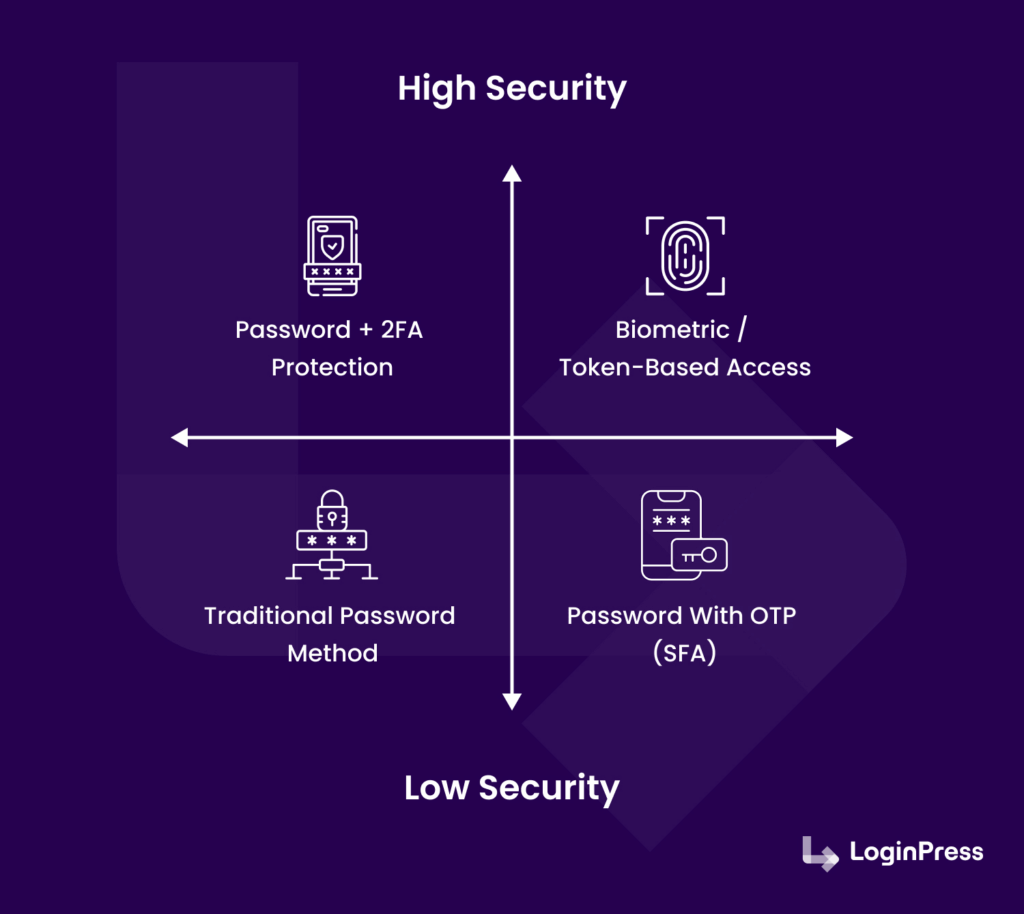
By removing the weakest human element, passwordless security raises the standard for digital protection across the entire system.
Is Passwordless Security Safe?
Despite the improved security, it’s fair to ask: Is passwordless auth safe from all vulnerabilities? No system is 100% immune, but security protocols are in place to resist the risks associated with passwordless methods like magic links or OTPs.
Here are some of the security concerns you might have over passwordless security:
- Security of Email-Based Magic Links: The primary concern is whether a user’s email is compromised, allowing an attacker to gain access. However, this poses an equal risk to traditional systems, where a compromised email enables an attacker to use the “Forgot Password” link with ease.
- Protection Against Man-in-the-Middle Attacks: Intelligent MitM attacks, where a fraudster intercepts the communication stream, can attempt to bypass basic 2FA. However, the most modern passwordless security methods, particularly those built on the FIDO (Fast Identity Online) standard, like Passkeys, are explicitly designed to prevent these attacks by cryptographically authenticating the session to the user’s device and the correct website domain.
LoginPress ensures a safe login experience by utilizing highly secure methods:
- Social Login: By making use of providers like Google and Facebook, your WordPress site benefits from the multi-billion-dollar security investments of these tech giants. Learn more about the 15+ Benefits of Social Login (2025).
- Auto Login: The system generates cryptographic tokens for each login attempt, which are securely verified before granting access. This method ensures that the passwordless login in WordPress remains protected against spoofing.
Ultimately, since a static password can be stolen once and reused forever, passwordless authentication provides a significantly safer and more resistant defense compared to traditional password-based authentication.
Benefits of Implementing Passwordless
Beyond the basic security improvements, passwordless delivers benefits for both users and site administrators. Let’s examine some of the benefits of implementing passwordless security.
Enhanced Security: By preventing the majority of breaches that start with compromised credentials, passwordless greatly reduces the chances of unauthorized access and prevents common attacks like phishing, which remain a top threat in 2025. Eliminating the password removes the single most significant attack target, shifting security to stronger, device-level controls.
User Experience: With passwordless login in WordPress, users enjoy fast logins. Users don’t have to remember complex passwords or go through frustrating reset cycles. Methods like social login enable single-click sign-in, reduce friction, and improve conversion rates for e-commerce and membership sites. A fast, hassle-free login process translates to lower cart abandonment and higher user engagement.
Reduced IT Burden: Forgetting passwords is the number one cause of support tickets. By eliminating passwords, passwordless solutions drastically reduce the burden on IT teams for managing endless password resets, saving time and money. A unified, passwordless system simplifies security policy enforcement, making it easier for administrators to maintain a high level of security.
Passwordless Solutions for WordPress
Passwordless auth solutions, such as social login and magic link authentication, help to eliminate the need for traditional passwords while ensuring strong security and a seamless user experience.
There are many passwordless solutions plugins available, such as LoginPress, the Biometric authentication by AwareID plugin, Magic Links by Magic Login plugin, among many others.
But LoginPress stands out as the most complete solution, with built-in options like Social Login and Auto Login. LoginPress goes beyond standard passwordless tools, setting a new standard for WordPress security plugins.
How to Set Up Passwordless Login in WordPress with LoginPress (Step by Step)
The fastest way to implement passwordless auth is through the LoginPress Social Login feature. Here is how you can set up passwordless login in WordPress using Google as an example:
Step 1: Install and Activate LoginPress Pro
First, ensure you have the pro version of LoginPress installed and activated on your WordPress dashboard.

Step 2: Access Add-Ons
Navigate to the LoginPress menu in your WordPress admin area and click on Add-Ons.

Step 3: Enable Social Login
Locate the Social Login add-on and turn it on. This instantly activates the core passwordless feature.
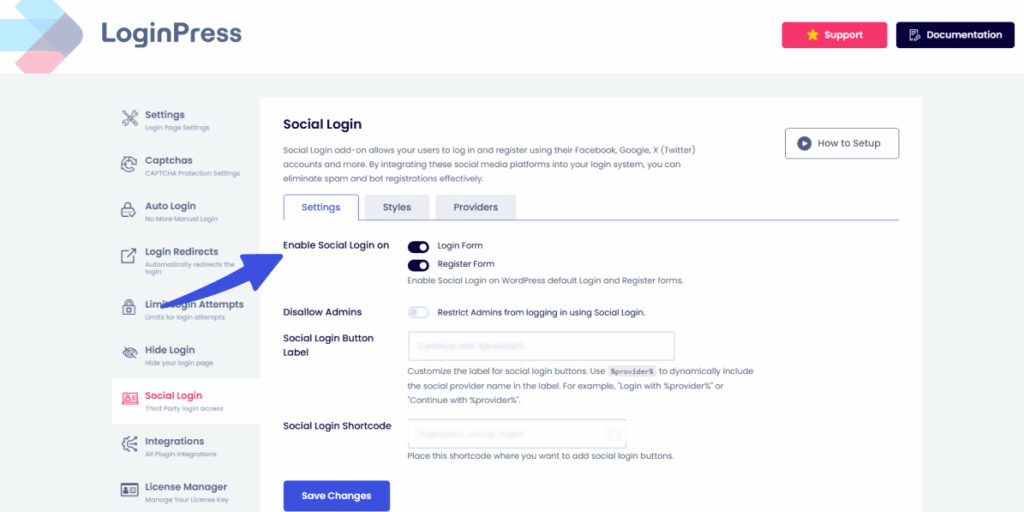
Step 4: Configure Social Login Providers
Navigate to the Providers Tab. Here, you’ll see options for Google, Facebook, etc. In this example, let’s choose the Google social login.
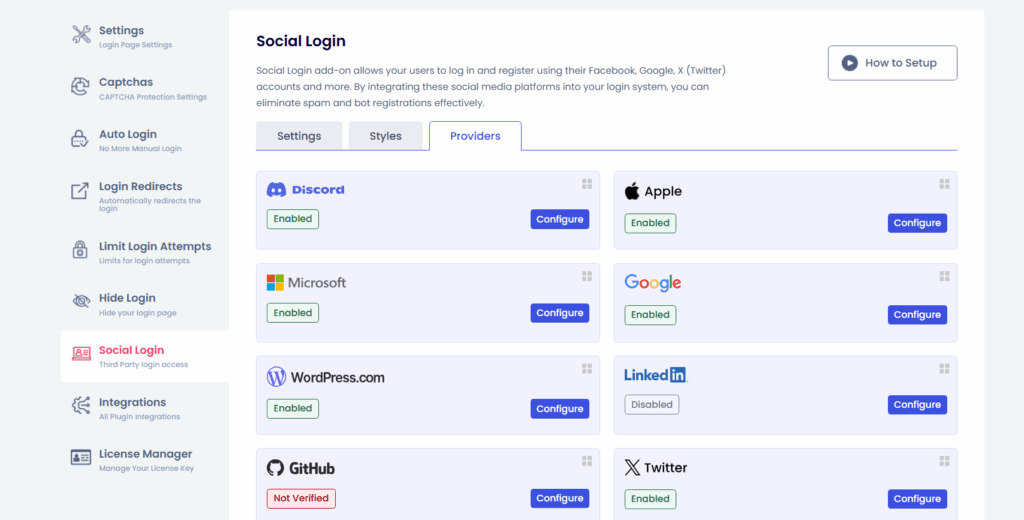
Step 5: Set Up Google Credentials
To enable Google social login, you need to generate an App ID and App Secret from the Google Developer Console (LoginPress provides direct links and simple instructions for this). This is a one-time step that securely connects your site to Google’s authentication system.
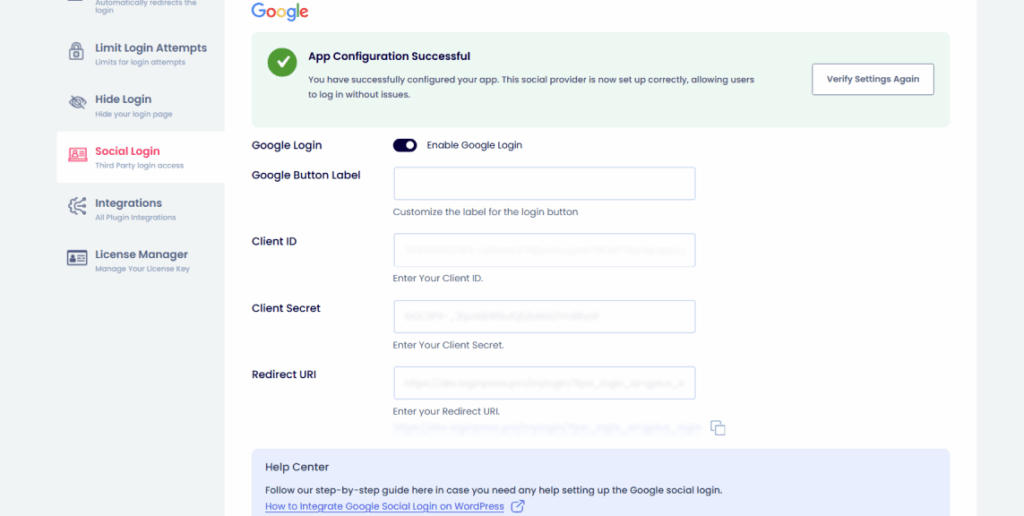
Step 6: Save Changes
Click on the Save Changes button.
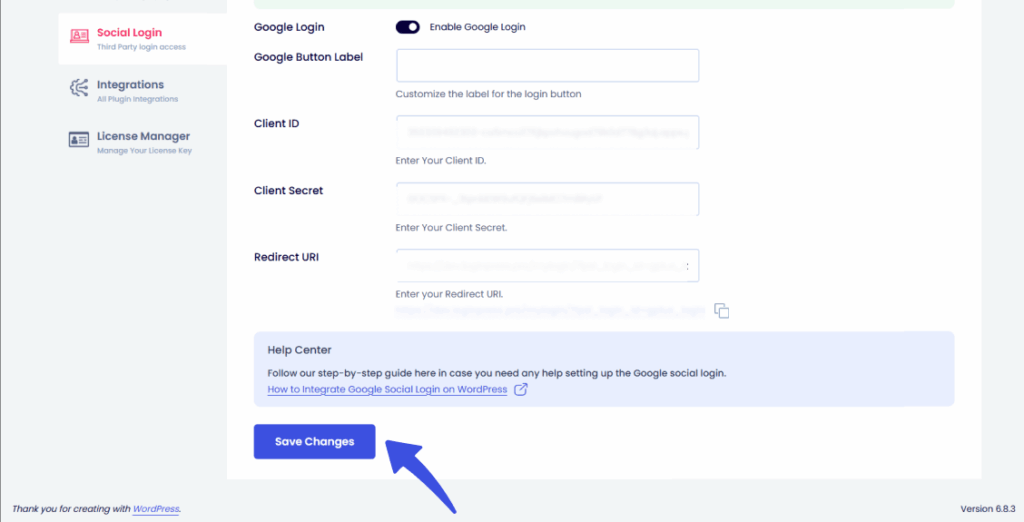
The Google login button (and any others you enable) will now automatically appear on your WordPress login screen.
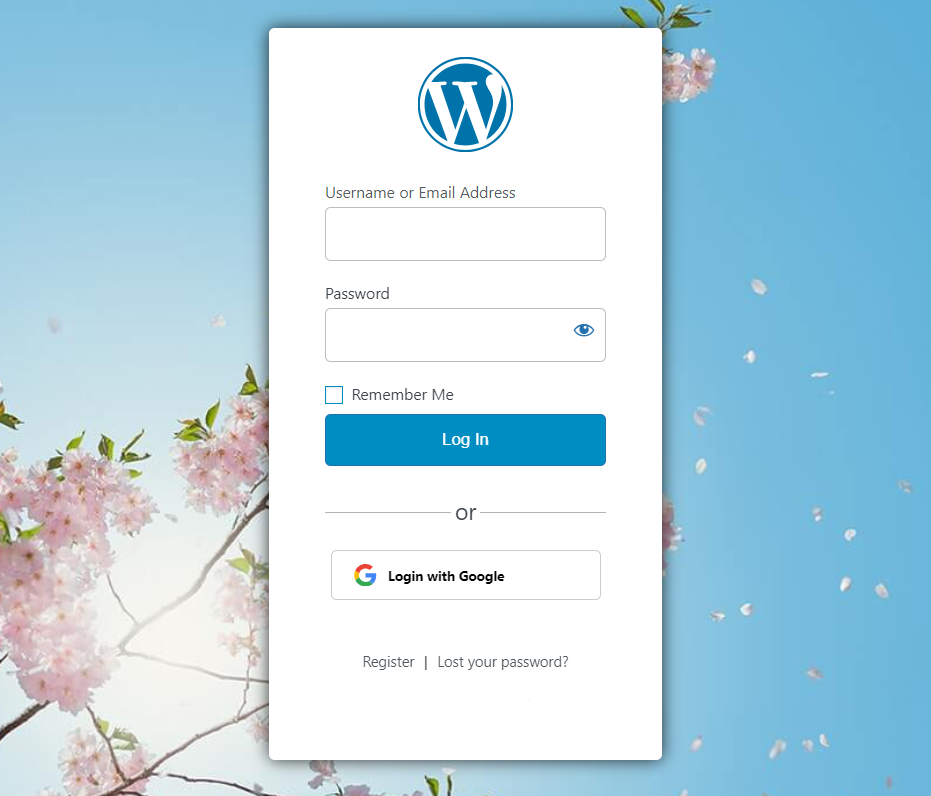
Your users can now log in instantly without ever typing a password! This simple setup delivers a massive security upgrade, proving that shifting to a passwordless security standard doesn’t have to be complicated.
FAQs on Passwordless Auth
Is passwordless more secure than a strong password with 2FA?
Yes. While a strong password with 2FA is highly secure, it remains vulnerable to advanced attacks, such as MitM/Adversary-in-the-Middle, which can capture the session token. Accurate passwordless security, especially methods like FIDO Passkeys, is inherently resistant to these attacks because it does not rely on a shared secret (the password) that can be intercepted.
What is the main benefit of using LoginPress for passwordless login in WordPress?
The main benefit is the combination of passwordless security with superior user experience. LoginPress integrates powerful, secure social logins and magic links directly into your branded WordPress login page, reducing friction for users while eliminating the single most significant security risk, which is the password.
Are magic links truly secure?
Yes. Is passwordless auth safe with magic links? Magic links are safe because they are single-use, time-sensitive tokens sent to a verified email address, making them resistant to brute-force and credential stuffing. The risk is limited to the security of the user’s email inbox, which is the same risk faced by a password reset link in a traditional system.
Does passwordless eliminate the risk of all cyberattacks?
Is passwordless more secure than a strong password with 2FA?
No system eliminates all risks. However, passwordless auth dramatically reduces the risk of attacks that target passwords, such as phishing, credential stuffing, and brute-force attacks, which account for the vast majority of security breaches.
Final Thoughts
The question: if passwordless auth is more secure, has been answered by the industry, and this is the superior choice for modern digital security in 2025. By removing the password, which is the single most compromised component of online security, going passwordless strengthens defenses against the most common and damaging cyberattacks.
The adoption of passwordless security with solutions like LoginPress not only future-proofs your WordPress site against evolving threats but also delivers a significant benefit to your users through a faster and frictionless login experience. The integration of passwordless login in WordPress via social logins and magic links makes LoginPress the best choice for site owners.
This is all for this article. For more related posts, check:
- Passwordless vs MFA: Key Differences
- Passwordless Ecommerce: Is it the Future?
- How MFA Improves Security Over Single-Factor Authentication
So don’t let vulnerable passwords be the weakest link in your security chain. Let us know what difference you feel after you upgrade to passwordless auth?



